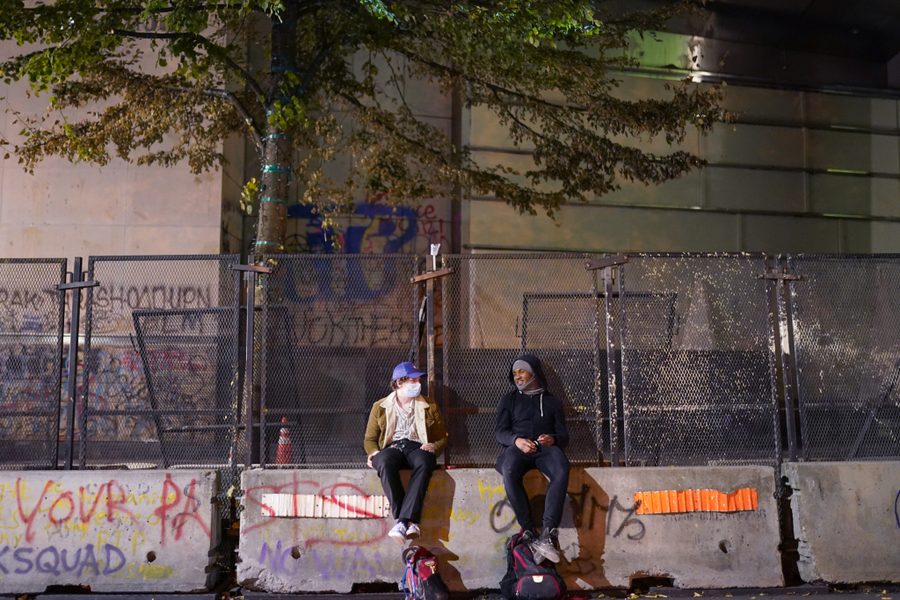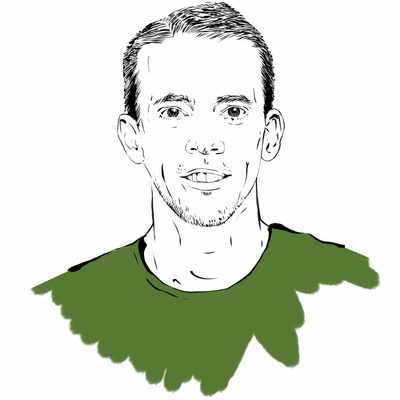
Timing is everything. “FEDS GO HOME,” read the more polite graffiti scrawled on Portland’s walls. “FEDS GO HOME,” read the signs waved by protesters. “FED’S GO HOME,” read the grammatically revolutionary t-shirt I bought on a downtown street corner. Last Thursday — the day I arrived in Portland — the federal agents did, in fact, go home (or at least withdrew from downtown and ended their occupation of the federal courthouse, which had been the primary target of protests). Thus I was able to entirely miss the dramatic nightly assaults of unidentified troops in fatigues clearing city blocks with guns drawn. But without the flamboyant violence and billowing tear gas, it became easier to see that what is happening in Portland was never really about the feds at all.
The Mark O. Hatfield Federal Courthouse may be a normal-looking building during normal times, but now it has the appearance of a looming tower of doom — an enormous, white, sealed-off, impenetrable Death Star, appropriate for center stage in any film about fascism’s rise. After many weeks of nightly protests in the park across the street, the government had installed outward-facing floodlights on the facade, forcing you to shield your eyes to look at it, adding to its hostile vibe. It is no longer a functional building so much as it is a sword wielded by the Trump administration as it desperately tries to assert its own strength. What the feds failed to reckon with was the fact that the people of Portland had much bigger plans than just playing a bit part in the president’s global search for any distractions from his own inadequacies.
The city of Portland is 77% white and less than 6% Black. Its affinity for the Black Lives Matter movement is heartening, because it represents a conscious act of solidarity that has produced almost 70 straight days of protests, and has seen thousands of Portlanders endure bouts of violent oppression in order to make their point. At the same time, like many mostly white and upscale cities, there is an element of absurdity in the overlapping parts of our current cultural moment. Every beer garden and juice bar sports “BLACK LIVES MATTER” banners, while people sleep on the sidewalk outside; the Louis Vuitton store has boarded up its windows in fear of riots, and then painted a “Power to the People” mural over the boards; a local souvenir shop has posted a sign alerting refugees that “We Stand With You. You Are Safe Here,” as if Oskar Schindler had suddenly started a new life selling “Keep Portland Weird!” t-shirts. It can all be a bit much. But the effort is not something to be mocked. It is, rather, a sign of just how deep the roots of this movement are reaching into the American psyche.
Portland is not immune from our nation’s acute crises. Homeless people are everywhere. Tents and sleeping bags line the city’s sidewalks from Nob Hill to the banks of the Willamette River. It is a shocking humanitarian disaster, familiar to anyone who has recently walked the streets of San Francisco or New Orleans or Philadelphia, and becoming inured to it is dangerous to the soul. The pandemic, which has shuttered most stores and left urban cores empty of businesspeople, shoppers, and tourists, leaves the homeless as the last permanent residents of entire business districts. The unemployment crisis and its subsequent evictions will leave more people homeless. The budget cuts hitting the city and state governments that provide housing and services will leave more people homeless. And the human tendency to pull inwards and shut our doors in times of fear will cut off help and leave more people homeless as well. The streets of Portland today are a preview of what is coming everywhere, unless something changes radically.
The pandemic, the unemployment, the years of poverty and broken government and police violence, George Floyd, Breonna Taylor — these are the things that set off the protests everywhere. The addition of the armed federal stormtroopers into this mix was just the secret ingredient that propelled Portland to a sort of pinnacle of political chaos. By the time I arrived, so much tear gas had soaked into the dirt and trees and sidewalks of Lownsdale Square, the park across the courthouse, that just standing in it made me start to cough, even though there was no tear gas fired that night. The protest veterans who had been out for weeks on end already seemed unaffected, like people who grow up in a mill town and stop noticing the stink. The violence was all fresh enough that most people came prepared: hard hats or bike helmets, along with respirator masks and goggles, and a grab bag of body armor and homemade shields. The atmosphere was tense, like a crowd that had just poured out of a concert venue where there were a bunch of fights. Nobody quite believed that the feds weren’t about to come rushing back at any moment. One young woman held a sign that best captured the moment: “Pulling out won’t stop people from coming.”
The entire courthouse had been fenced off in Riot Chic style, with high metal grates sandwiched between two heavy concrete barriers. Because of this draconian defensive maneuver, all of the graffiti that had been scrawled on the courthouse was still there, perfectly preserved, while the city of Portland cleaned the graffiti off other city buildings each day. This was a fair demonstration of the wisdom that the federal government has displayed in the city. The idea that all of this rigmarole needed to happen to “protect federal property” is absurd. You could lob a dozen hand grenades at the imposing cement face of the courthouse and not come close to knocking it down. No amount of fireworks, hurled water bottles, and spraypaint could do any real damage. Everything that the aggressive federal agents did to the people of Portland is a case study in how overreaction can backfire.
The state police who took over for the federal agents last Thursday have pursued the radical new tactic of staying inside the building all night, rather than attacking the crowd and firing tear gas. Since the police have decided not to attack anyone, there have not been any clashes. Incredible how that works. It is rare to even spot an officer at the courthouse anymore after dark, once the hundreds of people gather out front and begin the speeches and chants each night. Occasionally a single officer will venture out on a ledge many stories high to peek down at the crowd, and whenever that happens he is immediately painted with red and green laser pointers, until he resembles a tacky Christmas decoration.
Of all of the overt demonstrations of fascist tendencies that this White House has made, the federal agents’ heavy-handed presence in Portland was the longest-lasting. Resisting it openly therefore took on an added importance for any institution claiming to offer a path to a progressive future. For organized labor, participation in the Portland protests has been a member-driven affair. At 9:30 p.m. on Saturday night, hundreds of people gathered at the Salmon Street Springs in the waterfront park downtown to prepare to march over to the courthouse three blocks away. Amid the veterans in U.S. Army t-shirts ready to form the “Wall of Vets” and the mothers in yellow t-shirts ready to form the “Wall of Moms” stood a knot of union members huddled around a young man in a blue hardhat holding a handwritten “Union Members Here!” sign. This was the second of three weekly “Solidarity Wall” marches, an effort to put union members on the front lines of the protests. The event was organized not by a union or by the Central Labor Council, but by a regular AFSCME member who was extremely earnest about not wanting to appear in any story, lest she be seen as distracting from the BLM cause. About 50 union members turned out: many in green AFSCME shirts, but also teachers from the Oregon Education Association, members of the local Amalgamated Transit Union carrying a banner, and others from the Ironworkers, the Carpenters, the Teamsters, SEIU, UFCW, OPEIU, grad students and more.
In a move that longtime union members will recognize, our march got going late because we first had to have a lengthy discussion of rules and procedures. (One of the rules was “Don’t talk to media unless you are BIPOC [Black, Indigenous, People of Color],” which was unfortunate for me given the predominance of white people in the group.) But the event was just a staging ground for the future. The organizer spoke of long-term organizing within Portland’s unions to make racial justice a priority, and to end their affiliations with police. The motivation, the organizer said, was “just to make sure we’re on the right side of history.” The fact that the entire union presence at the protest was organized by members rather than by union leaders spoke to the urgency of that need.
Our group finally marched to the courthouse, and stood up against the barriers, and followed in the chants being led by the Black protest leaders up front. The whole thing embodied, in a sweet way, a certain quality that strong unions should offer to a broader social justice movement: the willingness to support without seizing control, to show up and offer solidarity without making demands. That is what the labor movement should provide as a matter of course. We still have a long way to go.
What’s happened in Portland in the past month is a preview of… something. Either a peek over the edge of our downward descent into dystopia, or a rallying point where the people of a city held the line and started beating back a cheap dictator’s crude stabs at control. I don’t know which yet. Last weekend, the protesters projected “FED GOONS OUT OF PDX” on the side of the federal courthouse, and their wish has (provisionally) come true. But the fed goons weren’t ever the real substance of the problem. It’s all the other stuff that’s still there. At one point, a speaker with a bullhorn, dripping with sweat in the August heat, exhorted the crowd, which had already shown up for weeks and weeks, before and after the cameras and the soldier and the tear gas, and still came out to scream at the blank, faceless symbol of the police state’s power.
“They ask how long the protest is gonna last,” he hollered. “The protest is gonna last — forever!”
Hamilton Nolan is a labor writer for In These Times. He has spent the past decade writing about labor and politics for Gawker, Splinter, The Guardian, and elsewhere. More of his work is on Substack.







